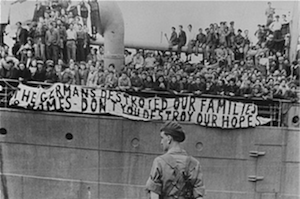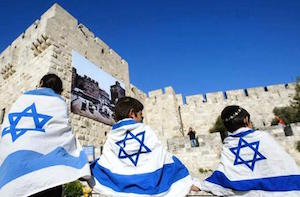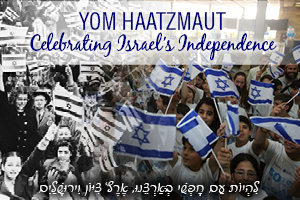The Dream of a State was Fulfilled
By Eric Gartman
Israel’s Independence Day, Yom Ha'Atzmaut, is upon us. As we celebrate the birth of the Jewish State, let us take time to examine a little-known but crucial event that occurred two days before David Ben-Gurion officially read the Declaration of Independence of the State of Israel.
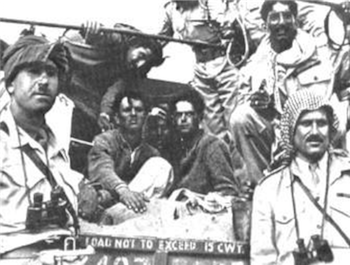
Arab Legion commanders pose with two of the four Jewish survivors of the Fall of Gush Etzion, May 13, 1948.
On May 12, 1948, David Ben-Gurion gathered the provisional government’s council in Tel Aviv for what was the most important meeting in Israel's history, if not the entire 3,000-year span of Jewish history. The outcome of their meeting would decide the fate of the Jewish State. A few days earlier, the US State Department had warned the Jews that they were outnumbered and could not prevail in a war with the Arab states, who were poised to invade on May 14. They recommended the Jews accept a truce. But while a truce would prevent an Arab invasion, it would postpone the establishment of a Jewish state.
To Ben-Gurion, the proposal was anathema. After two thousand years in exile, he would not consider postponing the creation of a Jewish home. But others in the provisional council wavered. They feared an Arab invasion would mean the deaths of all their hopes. The diminutive leader had guided the Jewish Agency through many crises in the past.
With his iron will, magnetism, and boundless energy, he was the undisputed leader of the Yishuv. Determined to win the vote, Ben-Gurion went so far as to fly a cabinet member in from besieged Jerusalem to Tel Aviv, as he knew he could count on his vote. Even with this extraordinary measure, the outcome of the vote remained uncertain.
The ten members of the council gathered. Ben-Gurion sat at the head, with his usual open-collared shirt and unruly hair. Moshe Sharett spoke first, relaying the American suggestion to not proclaim a state. Ben Gurion then played the first of his two cards designed to sway the vote in favor of statehood. Golda Meir reported on her secret mission to dissuade Jordan's King Abdullah from war. The negotiations had failed—Jordan would invade.
The mood in the room darkened. Ben-Gurion's first gambit had failed. Next, the Haganah commander gave a military assessment. "The conventional forces of the neighboring states, with their equipment and weapons, have an advantage,” Yigael Yadin explained, If I wanted to sum it all up and be cautious, I'd say at this moment, our chances are about even. If I wanted to be more honest, I'd say that the other side has a significant edge."
There was a stunned gasp in the room. It seemed to the council members that delaying statehood was the only way to prevent their destruction. Privately, Ben-Gurion fumed at Yadin’s report. But then the Jewish leader played his trump card. He knew something that the Americans did not know when they issued the warning. He opened two files containing reports from agents he had sent to Europe to purchase arms. Slowly and dramatically, he read the contents of the reports, reading out the figures for maximum effect. His agents had purchased 30,000 rifles, 5,000 machine guns, over 200 artillery pieces, twelve mortars, ten tanks, and thirty airplanes. Calling a truce would mean depending on the mercy of others at the very time when the youth were being conscripted and heavy arms were coming in. "If we can increase our forces, widen training, and increase our weapons, we can resist and even win," Ben-Gurion declared. The Jews might not ever get another chance at statehood. Now was the time. "I dare to believe in victory. We shall triumph!
Silence permeated the room as the members digested the news, transfixed by their leader’s radiance and confidence. If they voted to accept the truce, they would not have a state, but might live to fight another day. If they rejected the truce, they would have their state, with a bloody battle to secure it. The moment truth arrived. Ben-Gurion called for a vote. By six to four, the council rejected the American proposal. They would announce the establishment of a Jewish state two days hence.
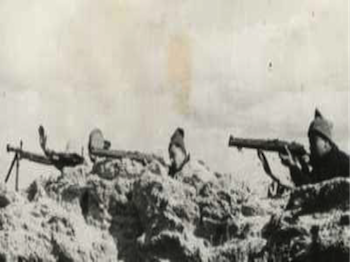
The last stand of the defenders of the Etzion Bloc, 12-13 May 1948. “The Arabs are everywhere, there are thousands of them. They are blackening the hills." And "the Arabs are in the kibbutz. Farewell."
The high price of rejecting the truce became apparent the very next day. The isolated Etzion bloc south of Jerusalem had been under attack by Arab irregulars. They had taken many losses but had held out. With the arrival of a regular army, the Jordanian Arab Legion with their armor and artillery, the defenders stood no chance. All the Haganah command in Jerusalem could do was listen in anguish as radio reports came in: "We are heavily shelled. Our situation is very bad. Their armored cars are 300 yards from the fence. Every minute counts. Hurry the dispatch of planes."
An hour later: "Heavy fire of artillery, mortars, and machine guns. The birds [airplanes] have not yet appeared. We have about 100 killed and many wounded. Establish contact with the Red Cross or help in any other way."
But there would be no help. The only airplane sent turned back from mechanical failures. As the battle raged, more reports came in: "The Arabs are everywhere, there are thousands of them. They are blackening the hills." And "the Arabs are in the kibbutz. Farewell." The last message received in Jerusalem read, "A desperate Masada battle was waged in the village." The Etzion Bloc had fallen. The triumphant Arabs ordered the remaining defenders to lay down their arms and line up for a photograph. As they did, a gunman shot all fifteen captives from the Jewish communities they had destroyed.
Approximately 150 had died defending the Etzion Bloc. Only four survived. The Jewish state was being born under the very threat of annihilation.
Nonetheless, on May 14, 1948, leaders of the Jewish Agency gathered at a museum in Tel-Aviv. For one of the few times in his life, David Ben-Gurion wore a suit-and- tie instead of an open collared shirt, underscoring the importance of the occasion. At 4 P.M., he rose and stood underneath a picture of Theodore Herzl. He rapped the table in front of him three times with a walnut gavel. Solemnly, he read the Declaration of Independence of the State of Israel, explaining the historic, legal, and moral justification for the Jewish state:

David Ben Gurion, who was to become Israel's first Prime Minister, reads the Declaration of Independence on May 14, 1948: “It is the self-evident right of the Jewish people to be a nation, as all other nations, in their own sovereign state. By virtue of the natural and historic right of the Jewish people and of the Resolution of the General Assembly of the United Nations, we hereby proclaim the establishment of the Jewish State in Palestine to be called Israel.”
With this, the State of Israel was born. As it turned out, Ben-Gurion was correct. The Jews triumphed in the war with the Arab states. Yet it had all hung on a narrow vote taken under the possibility of annihilation.
This Yom Ha'Atzmaut let us remember the brave members who voted for statehood and war, rather than for the truce and subsequent postponement of the Jewish state. As a result of the courage, the dream of the State of Israel was fulfilled.

Born in Israel to American parents, historian Eric Gartman never lost his fascination for the Jewish homeland. He is the author of Return to Zion: The History of Modern Israel, (2015), a critically-acclaimed narrative of the birth and survival of the Jewish State.
Recommended:
RAISE YOUR FLAG
Demonstrate your solidarity with Israel today!
About the Author


